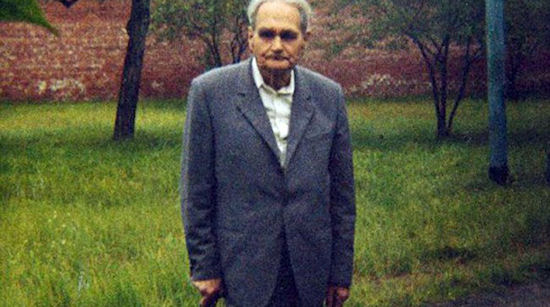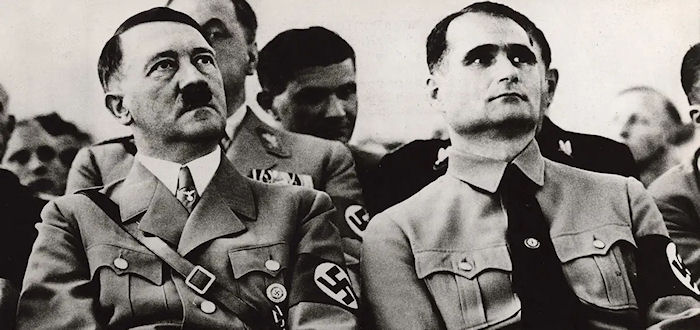Rudolf Hess was born on April 26, 1894 in Alexandria, Egypt. His father was a wealthy Bavarian merchant. He grew up in Alexandria until the age of 12 when he was sent back to Germany to continue his education at Bad Godesberg.
In August 1914, Hess enlisted in the German army and fought in the First World War taking part in some of the toughest battles (Ypres, Verdun). In his service he was injured and was awarded military distinctions. By the end of the war he was trained as a pilot, but he did not take part in actual operations.
After the end of the war, Hess studied economics and politics at the University of Munich. There he was inspired by the teaching of Karl Haushofer, an old general of the German army, who formulated the theory of "lebensraum", the idea that Germany should seek vital growth space by expanding into eastern Europe. When he later became acquainted with Hitler, he presented him with the theory which became one of the pillars of Nazi ideology and the driving force of World War II.
After climbing into the Nazi hierarchy, in January 1933, when Hitler became Chancellor, Hess took office as a minister without a portfolio and a personal deputy to Hitler. In 1939, immediately after the invasion of Poland and the outbreak of World War II, Hitler appointed Hess as second in the succession line, immediately after Göring.
In May 1941 Germany was in control of Western Europe, England was constantly bombarded and the invasion of the Soviet Union was in the final preparations stage, scheduled to begin in June.
At that time, Hess was the protagonist of one of the most mysterious and inexplicable stories of World War II. Piloting a Messerschmitt Bf 110 fighter, he flew to Scotland where he parachuted as he run out of fuel without being able to locate the Dungavel House, belonging to the Duke of Hamilton, which was his destination. In Germany, he had left a letter to Hitler informing him of his intention to pursue peace talks with the British government so as not to force Germany to fight another war on two fronts.
Hess believed, based on the information provided by Albrecht Haushofer, son of his old mentor, that there was a powerful anti-war movement in Britain that would see favorably the prospect of peace with Germany and that the Duke of Hamilton had a leading role. For several months he secretly prepared his mission, updating his flying skills on modern aircraft.
In Britain, Hess's flight was accepted with skepticism and reflection on whether Hitler was aware of it and on the other hand about the real engagement of British citizens with pro-German views. Churchill, years later, wrote that, in his view, Hitler was ignorant of Hess's mission and the peace proposal.
In Germany, a furious Hitler was concerned at the possibility that Hess's move might have been part of a putsch aiming in his removal from power. At the same time, Hitler was afraid that Hess’ mission would result in disruption of Germany's relations with its allies, they believed that Germany was seeking unilateral peace with Britain. It is noted that both Italy in North Africa and Japan in Southeast Asia either were already fighting or openly claiming British possessions and a unilateral peace was against their interests. That is why Hitler was eager to denounce Hess and his mission and to send assurances to his allies that it was an unauthorized act of a seriously disrupted personality.
But the most important result of Hess's flight involved a third party. Stalin's inherent mistrust towards everyone, and especially the British, was fueled, not unjustifiably, at a time when there was already information and evidence of the impending German assault. Part of Stalin's reticence and secrecy over Western allies in the years to come has its roots in Hess's mission.
 |
Hess was detained in several places in England, including the Tower of London, until October 1945, when he was moved to Nuremberg, where he was tried along with the other top executives of the Nazi regime. He was sentenced to life imprisonment and incarcerated in Berlin’s Spandau in 1947, where he remained for 40 years, until August 17, 1987, when he was found dead in his cell at the age of 93.
Hess's mission in 1941, and while Germany was still in peak power, has intrigued historian and writers for decades: was Hitler aware of the peace proposal and was there any involvement of senior British Government officials, even Churchill, and / or British secret services?
Perhaps the most interesting piece of information about Hess's mission comes from Albert Speer, Nazi Armaments Minister, and Hess's co-prisoner for several years in Spandau Prison. Speer said that in their talks during their detention, Hess confided to him that his idea had come from supernatural forces in a dream: Germany would guarantee the integrity of the British Empire, and Britain would give Germany freedom of action in continental Europe. In this way, Germany could avoid a two-front war, as in the First World War. This explanation, probably presents the truth about his action, the result of the traumatic experiences of the 1st World War and the fear that history would be repeated.




